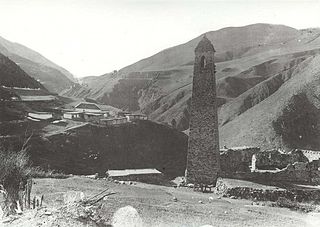Ingush or Ingushes, historically known as Durdzuks, Gligvi and Kists, are an ethnic group mainly inhabiting Ingushetia in central Caucasus, but also inhabitanting Prigorodny District and town of Vladikavkaz of modern day North-Ossetia. The Ingush are predominantly Sunni Muslims and speak the Ingush language.

The Nakh peoples are a group of North Caucasian peoples identified by their use of the Nakh languages and other cultural similarities. These are chiefly the ethnic Chechen, Ingush and Bats peoples of the North Caucasus, including closely related minor or historical groups.

The Orstkhoy, historically commonly known under their exonyms: Karabulaks, Balsu, Baloy, are a historical ethnoterritorial society among the Chechen and Ingush peoples. Their homeland is in the upper reaches of the Assa and Fortanga rivers in the historical region of Orstkhoy-Mokhk. In the tradition of the Chechen ethno-hierarchy, it is considered one of the nine historical Chechen tukkhums, in the Ingush tradition as one of the seven historical Ingush shahars.
Galashki is a rural locality in Sunzhensky District of the Republic of Ingushetia, Russia, located on the left bank of the Sunzha River near the border with the Republic of North Ossetia–Alania. Its population was about 9,000 people in 2009. Galashki forms the municipality of the rural settlement of Galashki as the only settlement in its composition.

Dzheyrakh - is a village and administrative center of Dzheyrakhsky District, in the Republic of Ingushetia, Russia.
The Fyappins were an Ingush subgroup (society). Historically they bordered on the west with Dzherakh, on the east with Khamkhins, on the north with Nazranians, and lastly in the south with Gudomakarians. The centre of the society was the fortified village (aul) of Erzi or Metskhal, while the region of their historical settlement was Fappi.

Fappi or Fappi Mokhk, exonym: Kistetia, is a historical region in Ingushetia. The center of Fyappiy Mokhk was village Metskhal. Fyappiy Mokhk is the territory of historical settlement of Ingush society Fyappiy.

Galashians, were a historical Ingush ethnoterritorial society, which formed in the middle of 18th century. The name comes from the village of Galashki, which is geographically located in the very center of the society. Galashians were located in the middle and lower reaches of the river Assa and the basin of the river Fortanga.

Ghalghaï is the self-name of the Ingush, a Caucasian people, that is most often associated with the word "ghāla" (гIала) – meaning "tower" or "fortress" and the plural form of the suffix of person – "gha" (гIа), thus, translated as "people/inhabitants of towers", though according to some researchers the ethnonym has a more ancient origin. Some scholars associate it with the ancient Gargareans and Gelae mentioned in the 1st century in the work of the ancient historian and geographer Strabo. In Georgian sources, in the form of Gligvi, it is mentioned as an ethnonym that existed during the reign of Mirian I, as well as the ruler of Kakheti Kvirike III. In Russian sources, "Ghalghaï" first becomes known in the second half of the 16th century, in the form of "Kolkans"/"Kalkans", "Kolki"/"Kalki", "Kalkan people".
Dzherakh, also spelled Jerakh, exonym: Erokhan people, were a historical Ingush ethnoterritorial society, that was formed in the Dzheyrakhin gorge, as well as in the area of the lower reaches of the Armkhi River and the upper reaches of the Terek River.

Kistinka is a river in Georgia that flows in the Khevi region. It originates at the foot of the Kibishi Glacier and flows to the northwest into the river Terek near the Russian-Georgian border. The length of the river is 17 km, the basin area is 79 km².
Arshty is a rural locality in Sunzhensky District of the Republic of Ingushetia, Russia, located on left bank of the river Arshtynka near the border with the Republic of Chechnya. It forms the municipality of the rural settlement of Arshty as the only settlement in its composition.

Yandare is a rural locality in Nazranovsky District of the Republic of Ingushetia, Russia. It forms the municipality of the rural settlement of Yandare as the only settlement in its composition.
Dattykh is a rural locality in Sunzhensky District of the Republic of Ingushetia, Russia, located on the left bank of the river Fortanga. It forms the municipality of the rural settlement of Dattykh as the only settlement in its composition.

Fortanga is a river in Russia that flows in Ingushetia and Chechnya. The length of the river is 69 km, the basin area is 526 km².

Vilayet Arshtkhoy,Vilayet Arshty,Arshtinskiy Vilayet, was an Ingush and administrative unit of the North Caucasian Imamate. The Naibstvo was the farthest region of the Imamate in the west and it was established on the territory of Orstkhoy society with the center being the village of Arshty.

Galgaï-Yurt was a village that was located in modern day Valerik in the Chechen Republic, Russia.

Meredzhi is a non-residential rural locality in Galanchozhsky District of the Republic of Chechnya, Russia.

Targim is an ancient city-settlement in Dzheyrakhsky District of Ingushetia. It is part of the rural settlement of Guli. The entire territory of the settlement is included in the Dzheyrakh-Assa State Historical-Architectural and Natural Museum-Reserve and is under state protection.

Falkhan is an abandoned aul in the Dzheyrakhsky District of Ingushetia. It is part of the rural settlement of Lyazhgi.














